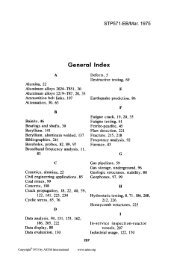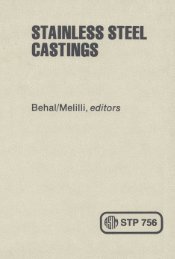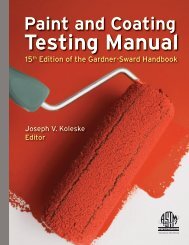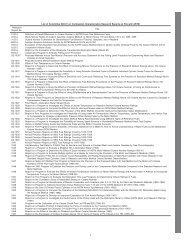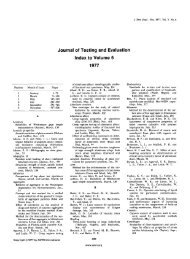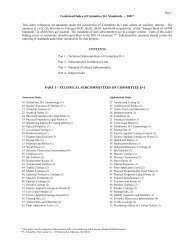Expandable Endotracheal Tube for Veterinary Patients - ASTM ...
Expandable Endotracheal Tube for Veterinary Patients - ASTM ...
Expandable Endotracheal Tube for Veterinary Patients - ASTM ...
You also want an ePaper? Increase the reach of your titles
YUMPU automatically turns print PDFs into web optimized ePapers that Google loves.
Feline Intubation Assist Device<br />
in the context of<br />
MEAM 099<br />
Yibin Zhang<br />
July 24, 2013<br />
1
Acknowledgements<br />
Dr. Robert Jeffcoat<br />
Dr. Lillian Aronson<br />
Peter Rockett<br />
Joseph Valdez<br />
And many thanks to <strong>ASTM</strong> International
1 Abstract<br />
A novel veterinary oral intubation assist device optimized <strong>for</strong> domestic felines with restricted airways was<br />
designed and prototyped. Oral endotracheal tubes are inserted through a patients airway in order to facilitate<br />
procedures that require tracheal penetration. Although endotracheal intubation is a routine procedure<br />
in animals with uninhibited airways, intubation in cats with restricted airways can be challenging because<br />
the procedure would be per<strong>for</strong>med with an available lumen <strong>for</strong> intubation of less than 1mm. This acute<br />
narrowing of the airway can lead to life threatening complications if not addressed immediately. This paper<br />
discusses the design of a novel intubation assist device that facilitates the insertion of the conduit by widening<br />
the airway in a manner that minimizes trauma.<br />
2 Background and Problem Definition<br />
In one case study, a 5-year-old male domestic shorthair cat underwent intubation as part of the regular<br />
anesthesia process. Orotracheal intubation was per<strong>for</strong>med on the feline patient by an anesthesia technician.<br />
Following two failed attempts at guiding the tube through the airway, the tube was <strong>for</strong>cefully inserted, causing<br />
some physical trauma of the cats airway: blood was observed around the arytenoid cartilages 2 where<br />
the ETT passed through. A fold of tissue could be seen between the ETT and the patients left arytenoid. A<br />
laceration lateral to the patients right arytenoid was also observed post-extubation [2]. In both human and<br />
veterinary medicine, when general anesthesia is required <strong>for</strong> medical and surgical procedures, endotracheal<br />
tubes (ETTs) are inserted through the patients larynx to establish and maintain a patent airway. Small<br />
domestic animals usually experience no problems when using standard endotracheal tubes, but cats are at<br />
higher risk <strong>for</strong> upper-airway trauma in comparison to dogs [2]. Additionally, emergency situations that<br />
involve airway inflammation or tumors make it even is more difficult to penetrate the laryngeal opening and<br />
intubate the animal. Airway obstruction due to the closing of the vocal cords and inflammation may result<br />
from trauma.<br />
Airway Anatomy [5]<br />
The rima glottis 2 lies caudal of the epiglottis and describes the space between the two true vocal cords.<br />
The narrowing of the upper respiratory tract can lead to asphyxiation.<br />
In order to minimize injury to the arytenoids and larynx, it would be beneficial if a device that could<br />
harmlessly penetrate the rima glottis, then expand into an appropriately sized tunnel allowing <strong>for</strong> unblocked<br />
intubation, were available. This device could potentially be used in both human and veterinary patients<br />
1
when immediate access is required <strong>for</strong> emergency resuscitation procedures, including cases of trauma, oral<br />
or airway cancer, and in the intubation of morbidly obese patients.<br />
The most common endotracheal tube device is the Magill tube, an arched and cuffed plastic tube with a<br />
beveled end. While the beveled end of the Magill tube does aid placement of the instrument, it has led to<br />
unsatisfactory results in the intubation of animals with restricted airways.<br />
3 Solution Development<br />
In developing a solution, the following points were considered:<br />
• Clinical utility<br />
• Ease and speed of insertion and placement<br />
• Compatibility with prevailing surgical equipment and technique<br />
• Adequacy of airway maintenance<br />
• Adaptability to anatomical variation<br />
• Minimization of trauma<br />
• Cost of manufacturing<br />
One existing self-adjustable endotracheal tube design use a memory device that creates a collapsible<br />
middle portion, but the proximal and distal ends are rigid [3]. An expansion device based on a stent was<br />
previously developed [6]. A sheathed stent is located at the distal end of the conduit used to deliver gases<br />
to the patient, and is <strong>for</strong> inhibiting the body lumen from collapsing. A stand-alone device that aids in<br />
the expansion of the airway and allows <strong>for</strong> regular intubation procedure using the Magill tube is currently<br />
lacking.<br />
Specific analysis necessary <strong>for</strong> the design and fabrication of the intubation assist device include an evaluation<br />
of the expected <strong>for</strong>ces exerted by the larynx and trachea on the device in its expanded <strong>for</strong>m, and<br />
finding a configuration of material that can withstand and expand against these <strong>for</strong>ces. The pressure in the<br />
proposed expanding device and collar will be in the range of 20-30 cm H 2 O[4].<br />
Collar designs would require an expandable piece. To allow <strong>for</strong> variations in trachea and neck length, the<br />
final collar will also be flexible, although the prototype is not made of the final material. Additionally, the<br />
collar:<br />
• will not need to exceed 2 centimeters in length<br />
• will need to be available in assorted sizes <strong>for</strong> different breeds and situations<br />
• could be tapered (<strong>for</strong> easier insertion, low risk of fall-through)<br />
• could be spool-shaped (to remain securely in place throughout procedures)<br />
• could be made of hard or soft polymer<br />
• could have crenellated ends to facilitate moving with basket through glottis<br />
• would be disposable in humans, but could be reused if not damaged; autoclavable<br />
• can be fabricated in SEAS facilities: 3D print a pattern, make a mold<br />
2
4 Final Solution<br />
The final design includes an expansion device and collar 4 that will hold the rima glottidis open during<br />
intubation.<br />
<strong>Expandable</strong> Device<br />
<strong>Expandable</strong> Device, closed<br />
<strong>Expandable</strong> Device, opening<br />
<strong>Expandable</strong> Device, fully expanded<br />
4.<br />
The flexible expandable device will first be inserted into the airway and expanded fully, as shown in figure<br />
3
Collar<br />
Collar and Bayonet Connection<br />
Collar Passing Over Expansion Device<br />
Collar Interdigitating with Expansion Device<br />
4
Collar Interdigitating with Expansion Device<br />
Retraction of Expansion Device 1<br />
Retraction of Expansion Device 2<br />
A small collar 4 will be manually slid along the expandable device and interdigitate with the expanded<br />
portion, where it will fit snugly against the expanded airway. The collar will be released from the white placement<br />
device when the user turns the placement device slightly, adjusting the bayonet mount. The placement<br />
device is then removed. The expandable device is pulled into its closed configuration and removed from the<br />
airway, while the collar remains inside 4. Regular intubation can then proceed. While it is not shown in the<br />
prototype, the collar will be tapered to prevent sliding further down the airway. After the Magill tube has<br />
passed through the rima glottidis, collar will either be slid out naturally later removed using <strong>for</strong>eceps after<br />
extubation.<br />
4.1 Prototype Materials<br />
The expansion device is fabricated using a 1/128 diameter solid steel shaft and the following two types of<br />
Tygon tubing supplied from Cole Parmer Instrument Co:<br />
1. Tygon tubing with Inner Diameter 1/16, Outer Diameter: 1/8<br />
2. Tygon tubing with Inner Diameter 1/256”, Outer Diameter: 1/128<br />
The collar prototype is fabricated out of aluminum. Its distal end consists of three grooves to interdigitate<br />
with the expanded basket. Its proximal end consists of a bayonet mount to attach to a separate tube that<br />
5
will facilitate placement of the collar in the airway.<br />
Lastly, the handle of the prototype is made of a sliding tin box <strong>for</strong> ease of fabrication and functionality.<br />
While a functioning prototype has been developed, the images 4 depict a collar that is much larger than<br />
that of the actual design. Some refinement will be necessary to modify the expanding device so that each<br />
loop of the expansion device behaves like a beam undergoing deflection with fixed and simply supported end<br />
conditions.<br />
1. <strong>Expandable</strong> mainspring collar:<br />
A self-expanding sheet-metal or inert polymer mainspring strip initially coiled into thin tube and held by<br />
two thin shafts.<br />
Intubation:<br />
1. sheet coiled tightly <strong>for</strong> insertion<br />
Mainspring Collar<br />
2. release string and/or shafts to allow expansion of the collar<br />
3. mainspring will expand in glottal area<br />
4. remains in glottal area during intubation<br />
Extubation:<br />
1. remove endotracheal tube first<br />
2. rewind mainspring using a coiled mechanism such as that in USB rewind devices<br />
3. remove coiled mainspring safely from airway<br />
Advantages:<br />
• separate part allows usage of unmodified endotracheal tube<br />
• provides easy access <strong>for</strong> tube<br />
• protects glottis from further damage<br />
Disadvantages:<br />
• separate procedure necessary <strong>for</strong> insertion of tube<br />
• recoiling of mainspring can be inconsistent<br />
• risks associated with using metal sheets and springs<br />
2. Inflatable collar A silicone rubber balloon cuff will <strong>for</strong>m a collar in the rima glottidis when inflated.<br />
Intubation:<br />
6
1. select collar and place loosely around the flexible cable<br />
2. guide the cable to and through the glottis via largynoscope<br />
3. expand the basket end of the cable to <strong>for</strong>ce the glottis open to the desired degree<br />
4. advance the collar over the basket<br />
5. advance collar and basket together slightly, and through the glottis<br />
6. contract the basket and withdraw the cable entirely from the airway, leaving the collar in place<br />
7. proceed with intubation normally<br />
Extubation<br />
1. release and withdraw the trach tube<br />
2. withdraw the collar, presumably by grasping with <strong>for</strong>ceps<br />
Disadvantages:<br />
• difficult to control the volume of the lumen when expanded<br />
• difficulty of fabrication<br />
3. <strong>Expandable</strong> ”stent” Interface The Patient end of the endotracheal tube would be replaced with<br />
a sheathed expandable mesh that would originally be of small diameter, then expand upon entering the<br />
airway.<br />
Intubation:<br />
1. insert sheathed tube<br />
2. pull back sheath to allow tube to expand in airway<br />
3. proceed with intubation normally<br />
Extubation<br />
1. slide sheath over conduit and expandable mesh, recapturing it<br />
2. withdraw the ETT<br />
Advantages:<br />
• separate part allows usage of unmodified endotracheal tube<br />
• provides easy access <strong>for</strong> tube<br />
• protects glottis from further damage<br />
Disadvantages:<br />
• difficulty of interfacing stent design with traditional ETT<br />
• difficulty of guiding expandable portion through the rest of the airway<br />
• difficulty of recapturing sheath<br />
• difficulty of fabrication<br />
• uncertainty if mesh is strong enough to hold open airway<br />
• requires modification of traditional ETT<br />
7
5 Conclusion and Further Recommendations<br />
Some refinement will be needed to trans<strong>for</strong>m the prototype into a clinically feasible product. The design<br />
currently awaits cadaver testing at the Ryan <strong>Veterinary</strong> Hospital at the University ov Pennsylvania.<br />
The planning and development of the intubation assist device highlighted a number of concerns related<br />
to designing products <strong>for</strong> use in veterinary medicine. First, the selective coverage of veterinary pet insurance<br />
encourages the development of reusable, assistive products over that of completely new products that would<br />
replace tools that are currently widely used and mass-produced. Additionally, the product must be something<br />
that can be sterilized <strong>for</strong> use near living patients. And lastly, the anatomy and needs of veterinary patients<br />
can differ greatly amongst dissimilar breeds and species. This specific tool is developed to meet the needs<br />
of feline patients with restricted airways - a subcategory of domestic cats.<br />
8
References<br />
Aron DN, Crowe DT: Upper airway obstruction: General principles and selected conditions in the dog and<br />
cat. Vet Clin North Am Small Animal Pract 15(5):891917, 1985.<br />
Hofmeister, Erik H; Trim, Cynthia M,, Kley, Saskia Cornell, Karen. Traumatic endotracheal intubation in<br />
the Cat. <strong>Veterinary</strong> Anaesthesia and Analgesia. 2007, 34, 213-216.<br />
ONeil, Michael P. and Colburn, Joel C. (2010). Self-sizing adjustable endotracheal tube. U.S. Patent No.<br />
20100313896. Cali<strong>for</strong>nia.<br />
Sengupta, Papiya; Sessler, Daniel; Maglinger, Paul; Wells, Spencer; Vogt, Alicia; Durrani, Jaleel; Wadhwa,<br />
Anupama. (2004). <strong>Endotracheal</strong> tube cuff pressure in three hospitals, and the volume required to produce<br />
an appropriate cuff pressure. BMC Anesthesiol, v.4:8<br />
E-Safe: Safer Anaesthesia From Education. Session 14 01.<br />
Angel, Luis F. ”Airway assembly <strong>for</strong> tracheal intubation”. U.S. Patent No. WO2005018713 A2.<br />
9







